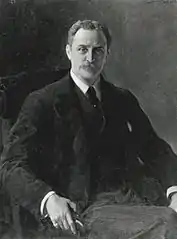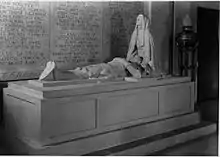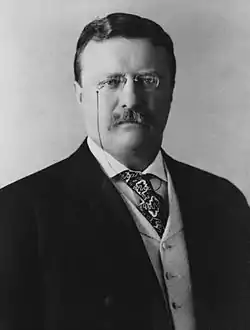Robert Bacon
Robert Bacon (July 5, 1860 – May 29, 1919) was an American statesman and diplomat. A leading banker and businessman, who worked closely with Secretary of State Elihu Root, 1905-1909, and served as United States Secretary of State from January to March 1909.[1] He served as ambassador to France 1909 to 1912. He was a leader in the Preparedness Movement setting up training programs for would-be Soldiers before the United States entered the First World War in April 1917. He was defeated narrowly as a candidate for the United States Senate in 1916. He was commissioned as a major in the United States Army in 1917, and played a major role as Chief of the American Military Mission at British General Headquarters.
Robert Bacon | |
|---|---|
 | |
| United States Ambassador to France | |
| In office December 31, 1909 – April 19, 1912 | |
| President | William Howard Taft |
| Preceded by | Henry White |
| Succeeded by | Myron T. Herrick |
| 39th United States Secretary of State | |
| In office January 27, 1909 – March 5, 1909 | |
| President | Theodore Roosevelt William Howard Taft |
| Preceded by | Elihu Root |
| Succeeded by | Philander C. Knox |
| 26th United States Assistant Secretary of State | |
| In office October 11, 1905 – January 27, 1909 | |
| President | Theodore Roosevelt |
| Preceded by | Francis B. Loomis |
| Succeeded by | John Callan O'Laughlin |
| Personal details | |
| Born | July 5, 1860 Jamaica Plain, Massachusetts, U.S. (now Boston) |
| Died | May 19, 1919 (aged 58) New York City, |
| Political party | Republican |
| Spouse(s) | Martha Waldron Cowdin |
| Children | 4, including Robert, Gaspar |
| Education | Harvard University (BA) |
| Signature | |
| Military service | |
| Allegiance | |
| Branch/service | |
| Rank | Lieutenant colonel |
Early life and family
Born in Jamaica Plain, Massachusetts, to William Benjamin Bacon and Emily Crosby Low, he was a graduate of Harvard University (Class of 1880), where he was a member of the A.D. Club and Delta Kappa Epsilon. He was married on October 10, 1883, to Martha Waldron Cowdin.[2] They had four children: Robert Low Bacon, Gaspar Griswold Bacon, Elliot Cowdin Bacon, and Martha Beatrix Bacon (1890–1967) who married George Whitney (1885–1963). Their son Robert was a United States Congressman; their other son Gaspar was the President of the Massachusetts Senate from 1929 to 1932 and Lieutenant Governor of Massachusetts from 1933 to 1935.
Career
He worked in the steel world, including partnership with J.P. Morgan & Co. for many years starting in 1894. He acted as J.P. Morgan's chief lieutenant and participated in the formation of the U.S. Steel Corporation and the Northern Securities Company. The pressure of the job shot his nerves, and he left the company in 1903.[2]
After Theodore Roosevelt (with whom he was friends at Harvard) had been reelected, Bacon was named Assistant Secretary of State in 1905, a position which he held until 1909; he was acting secretary while Elihu Root was in South America in 1906. For the last 38 days of Roosevelt's term, he became full secretary from January 27 to March 5, 1909, because of Root's election to the Senate.[2] Bacon obtained the advice and consent of the Senate for the Panama Canal treaties with Colombia and Panama. He served as United States Ambassador to France from 1909 until 1912.[2] He was supposed to return home on the RMS Titanic with his wife and daughter, but delays kept them in Paris.

In August 1914, he went to France to help with the work of the American Field Service – which provided ambulances and drivers to support French and British forces. He was also attached to the British Army Medical Corps and assisted with the establishment of a typhoid hospital near Ypres. His book For Better Relations with Our Latin American Neighbors was published in 1915.[3]
He was a staunch advocate of the United States' entry into World War I and spoke in favor of increased military preparedness via universal military service as the president of the National Security League in 1916. He criticized President Woodrow Wilson for inaction at the invasion of Belgium and sought the Republican nomination for U.S. Senate against William M. Calder. Bacon continued to push for a stronger national defense as well as a protective tariff that could be used for the mobilization of industry in case of war.[4] Although he had support from former president Theodore Roosevelt and Elihu Root, Bacon lost the race by about 9,000 votes and pledged to support Calder.[5][6][1] He was named as the candidate of the American Party but withdrew on account of his pledge to Calder.[7]
He was then commissioned a major in the U.S. Army in May 1917 before sailing to France as a member of General Pershing's staff. He was promoted to lieutenant colonel in 1918 and served as chief of the American military mission at British General Headquarters working with British commander, General Sir Douglas Haig. He returned to the United States in April 1919.[2]
Bacon died on May 29, 1919, from blood poisoning after undergoing surgery on his mastoiditis.[1]
Memorial

A sculpture entitled The Sacrifice was made by Malvina Hoffman as a memorial to the late Ambassador of France, Robert Bacon, and alumni of Harvard University who lost their lives during the World War I. In it, the head of a 13th-century crusader lay on the lap of a draped woman.[8] The sculpture was dedicated in 1923 at the Cathedral of St. John the Divine in New York.[8] After the War Memorial Chapel at Harvard University was completed in 1932, it was installed there.[9][10]
References
- "Col. Robert Bacon Dies In Hospital. Ex-Secretary of State Expires of Blood Poisoning After Mastoiditis Operation. Ex-Ambassador To France. Noted Financier Was Former Member of Firm of J. Pierpont Morgan. His War Services. Robert Bacon's Career. Aided Roosevelt in Coal Strike. Advocate of Preparedness. Criticised Wilson's Policies". New York Times. May 30, 1919. Retrieved March 25, 2011.
Colonel Robert Bacon, former Secretary of State and ex-Ambassador to France, died last night at 11:30 o'clock in the New York Eye and Ear Infirmary, as the result of the development of blood poisoning in the neck following an operation for mastoiditis ...
- Marquis Who's Who, Inc. Who Was Who in American History, the Military. Chicago: Marquis Who's Who, 1975. P. 22 ISBN 0837932017 OCLC 657162692
- Bacon, Robert. For Better Relations with Our Latin American Neighbors: A Journey to South America. Washington, D.C.: Carnegie Endowment for International Peace. Division of Intercourse and Education, 1915. OCLC 1438766
- "Bacon for Senator Gives His Platform; Files Petition and Declares for International Law and the Power to Enforce It". New York Times. August 16, 1916.
- "Bacon Concedes Calder's Victory; Defeated Candidate for Senate Nomination Will Take Stump for Hughes". New York Times. September 22, 1916.
- "Colonel Comes Out for Robert Bacon; Finds Universal Military Training a Vital Issue He Must Support". New York Times. September 19, 1916.
- "Bacon Withdraws as Candidate". New York Times. September 26, 1916.
- American Scenic and Historic Preservation Society (1922). Annual Report of the American Scenic and Historic Preservation Society to the Legislature of the State of New York. pp. 41–42.
- David Bernard Dearinger (2004). Paintings and Sculpture in the Collection of the National Academy of Design: 1826–1925. Hudson Hills. p. 276. ISBN 978-1-55595-029-3.
- Paula E. Calvin; Deborah A. Deacon (September 8, 2011). American Women Artists in Wartime, 1776–2010. McFarland. p. 84. ISBN 978-0-7864-8675-5.
Further reading
- Davis, Calvin D. "Bacon, Robert (05 July 1860–29 May 1919)" American National Biography (1999) https://doi.org/10.1093/anb/9780198606697.article.0600017
- Jessup, Philip C. Elihu Root (2 vols., 1938)
- Scott, James Brown. Robert Bacon: His Life and Letters (1923).
- Scott, James Brown. “Robert Bacon: Secretary of State, January 27, 1909, to March 5, 1909,” in The American Secretaries of State and Their Diplomacy, vol. 9 ed. Samuel Flagg Bemis et al. (1928).
- "Robert Bacon." Dictionary of American Biography (1936) online
External links
| Wikimedia Commons has media related to Robert Bacon. |
| Political offices | ||
|---|---|---|
| Preceded by Elihu Root |
U.S. Secretary of State Served under: Theodore Roosevelt January 27, 1909 – March 5, 1909 |
Succeeded by Philander C. Knox |
| Preceded by Francis B. Loomis |
United States Assistant Secretary of State September 5, 1905 – January 27, 1909 |
Succeeded by John Callan O'Laughlin |
| Diplomatic posts | ||
| Preceded by Henry White |
United States Ambassador to France 1909–1912 |
Succeeded by Myron T. Herrick |

